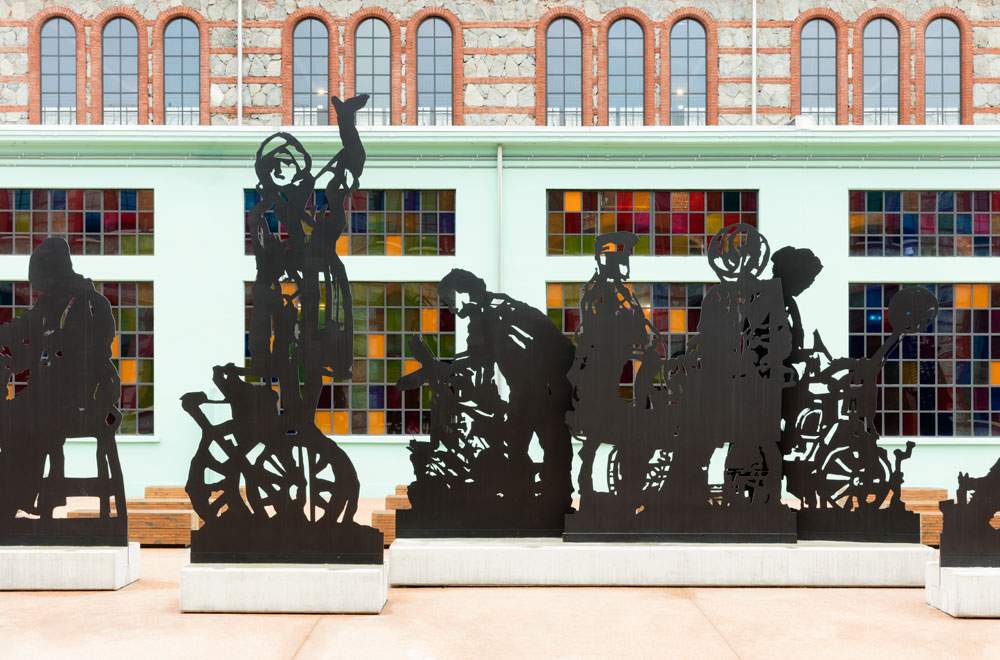OGR is launching a new online column How an exhibition is born, as part of the OGR is digital project. The initiative kicked off on Thursday, April 9, with the publication of photos, videos and unpublished materials on social channels. The first episode was dedicated to two permanent works at OGR: Procession of reparationists, a public and site-specific installation by William Kentridge, and Track, a work created by Arturo Herrera for the entrance wall of OGR Cult. Anecdotes, behind-the-scenes, and “behind the scenes” that preceded the inauguration of the installations on Sept. 30, 2017, were revealed.
There will be an opportunity to see the preparatory sketches that William Kentridge made inspired by old photographs of train workers in the OGRs and factories in Northern Italy, the sea voyage from South Africa to Italy of the fifteen monumental steel statues, hoisted by a crane in record time in the East Court of the Officine Grandi Riparazioni.
Procession of reparationists is a commission identified by the Castello di Rivoli-Museo d’Arte Contemporanea, supported by the Fondazione CRT per l’Arte Moderna e Contemporanea, and whose curatorship and production was entrusted to the Castello di Rivoli. The large metal plates (about 410 x 350 m) were shipped to Italy from South Africa, where the artist oversaw their production. After about a month of travel, the works arrived in Genoa and later in the East Court of the OGR. For the creation of the installation, Kentridge conducted research on the industries of Northern Italy, dwelling on photographs that portrayed workers and laborers: hence the highly significant and symbolic value of labor, an allusion to the process of repairing trains and bodies.
In the same days, during preparations for the grand opening celebration of the OGR Turin, work was done on Arturo Herrera’s majestic mural painting, Track: the work combines lines of various sizes and thicknesses, forming an intricate network that resembles the layout of railroad tracks or a series of paths that meet unraveling in various directions, also suggesting a tangle of branches and trees reaching upward. The mural painting was completed by Arturo Herrera and his two assistants, the Von Gunten brothers, not without technical problems. However, the work was unveiled on September 30, 2017 to the public and the press: a work that conveys energy, interconnectedness, and fluidity.
“We unveil the backgrounds of the works of two great contemporary artists of international renown, such as Kentridge and Herrera, which everyone will be able to admire again at the OGR as soon as they return to full prominence as Officine dell’Arte, della Cultura, della Ricerca, dell’innovazione. Restoring a new life to OGR has certainly been a complex but always exciting journey: we also want to share these ’behind the scenes’ of their rebirth with the public of OGR, so that they can appreciate them even more as a place that belongs to the whole community,” said Massimo Lapucci, Director General of OGR and Secretary General of Fondazione CRT.
Image: William Kentridge, Procession of Reparationists (2017; Turin, OGR) Ph.Credit Andrea Rossetti
 |
| The journey from South Africa to Italy of Kentridge's statues and Herrera's mural painting. OGR reveals its secrets |
Warning: the translation into English of the original Italian article was created using automatic tools. We undertake to review all articles, but we do not guarantee the total absence of inaccuracies in the translation due to the program. You can find the original by clicking on the ITA button. If you find any mistake,please contact us.